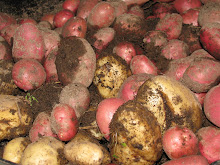By FAO, United Nations
Reduce emissions, remove greenhouse
gases and ensure food security
According to the 2007 Synthesis Report of the Intergovernmental
Panel on Climate Change (IPCC), the agriculture and forestry sectors
are responsible for a third of green house gas emissions (GHG) and
yet these same sectors also hold an enormous potential to reduce
emissions and also absorb carbon in vegetation and soils.
Agriculture can be part of the mitigation solution and the sector
deserves to be anchored in the implementation of international
agreements. Reducing the environmental footprint of agriculture
while meeting the growing demand for food, fuel and fiber can be
done.
Some mitigation options, particularly those related to soil carbon
sequestration can contribute to both food security and adaptation
goals. Reduction and removal of carbon can also be achieved by
improving cropland and grassland management, and restoring
degraded soils.
Around 13 million hectares of forests are lost annually due to
deforestation causing 17 percent of global GHG emissions (FRA
2005, IPCC 2007). Reducing Emissions from Deforestation and forest
Degradation (REDD) including sustainable forest management, forest
conservation and enhancement of forest carbon stocks also
can be an immediate answer.
Get it right
Adapt food systems to climate change
As the number of hungry in the world surpasses one billion, ensuring
adequate safe and nutritious food for all will require food systems to
adapt to climate change. Adaptation of the agriculture, forestry and
fisheries sectors to climate change will be costly but necessary for food
security, poverty reduction and ecosystem services.
Acting now rather than later could reduce the vulnerability of
hundreds of millions of farmers, and forest-dependant people who are
already food insecure especially smalholder and subsistence farmers,
pastoralists and fisherfolk, women and indigenous peoples.
No other sector is more sensitive to climate change than
agriculture and no other sector contributes so directly to the provision
of food and livelihoods of the majority of the poor in developing
countries. That’s why specific targeting of agriculture within adaptation
efforts, and their financing, is needed so that the sector can achieve its
multiple roles.
Concrete steps to face future risks of climate change impacts
include developing climate change impact assessments, encouraging
better water management, soil conservation, resilient crops and trees
and improving weather and climate forecasting as well as further
developing disaster risk management.
Capture synergies between food
security and mitigation
Potential synergies among food security, adaptation
and mitigation from land-based practices in developing
countries could generate high benefits to address the high
demands placed on these sectors.
However, some mitigation actions may not help
adaptation efforts and can sometimes conflict with food
security goals. Strategies and financing mechanisms will be
needed that enable these multiple benefits to be produced
and used by rural producers.
The most promising mitigation options include:
sustainable forest, cropland and rangeland management,
agroforestry, and restoration of degraded and organic soils.
Monday, December 7, 2009
Subscribe to:
Post Comments (Atom)

Copenhagen begins, this week is a major week for important decisions that will impact the future of our food. The article above from the United Nations food and agricultural organization suggests action must be our next step.
ReplyDelete